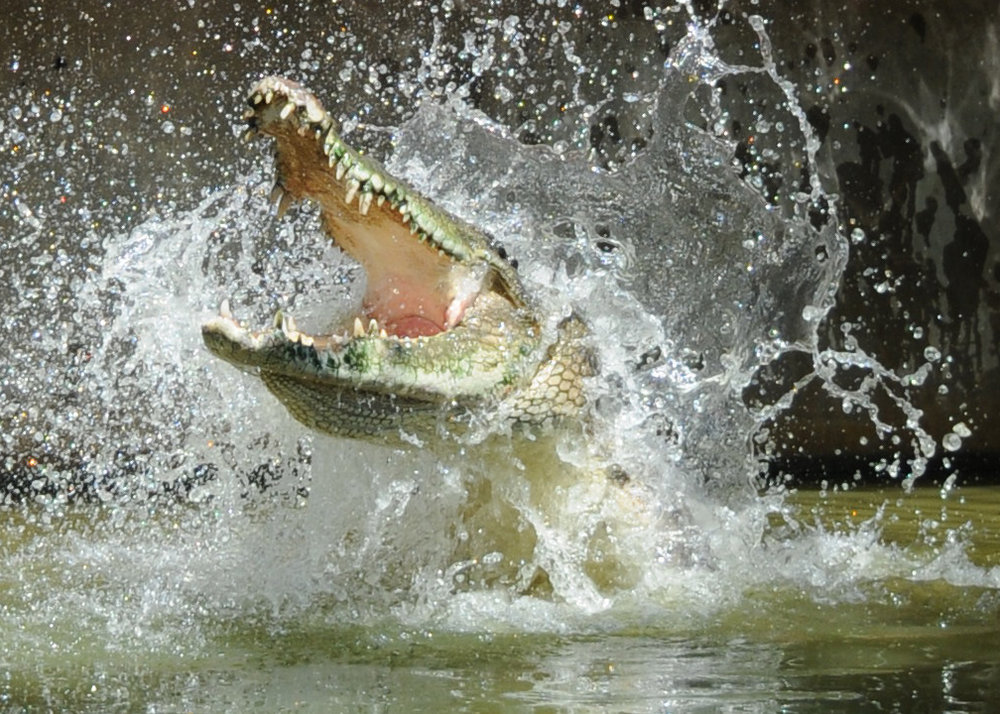
Dinosaurs may have produced their own body heat, making them warm-blooded, new research suggests.
The dinosaurs would have needed warm blood to fuel their muscles as they chased prey or fled from other dinosaurs, according to the new study.
The study, published July 5 in the journal PLOS ONE, compared several thrashing crocodiles' maximum energy output with that of similar-size, yet warm-blooded, mammals. The biggest crocodile produced only one-seventh of the muscle energy of mammals of similar size, suggesting cold-blooded physiology couldn't have kept up with large dinosaurs' active lifestyles.
"If you imagine a crocodile as a model dinosaur and pitted it up against a mammallike dinosaur with a mammalian physiology, it would be clear who would win the contest: The mammal would," said study co-author Roger Seymour, a plant and animal physiologist at the University of Adelaide in Australia.
Cold-blooded?
For decades, scientists believed dinosaurs were cold-blooded, or drew heat from the environment. Because they were fairly large and the temperature was warmer millions of years ago, the beasts could have kept a fairly stable body temperature by simply basking in the sun during the day and letting their bodies cool down very slowly at night. [Paleo-Art: Dinosaurs Come to Life in Stunning Illustrations]
The key difference between cold- and warm-blooded, or endothermic, animals is that warm-blooded animals (such as birds and mammals) use much more oxygen than ectothermic, cold-blooded animals (such as reptiles) to fuel their metabolisms, so they require a much higher caloric intake. A nice byproduct of that metabolism is body heat for endotherms.
Sign up for the Live Science daily newsletter now
Get the world’s most fascinating discoveries delivered straight to your inbox.
So, researchers argued, cold-blooded dinosaurs may have had an edge, because they could regulate their body temperature externally without having to gorge on quite as much food.
But mounting evidence suggests dinosaurs may have been warm-blooded after all. Bones suggest dinosaurs grew quickly, just as warm-blooded animals do, and that they weren't slow and sluggish, but active, like warm-blooded animals.
Crocodile hunters
In the 1990s, Seymour and his colleagues decided to test the endurance of big cold-blooded animals. In the dead of night, they ventured by boat into crocodile-infested waters in northern Australia. They would shine their flashlights into the crocodiles' eyes, and then loop a cord around the animals and watch them struggle.
Because the crocodiles perceived the capture as a life-or-death situation, they thrashed until exhaustion, at which point the boat dragged them ashore. The researchers then tied the crocodiles' snouts shut and took blood and muscle samples to measure how much energy their muscles had produced.
The bigger the croc was, the punier its muscles were.
A 2.2-lb. (1 kilogram) croc could produce just more than half the muscle energy of that produced by a similar-size mammal. And despite its terrifying appearance, the biggest crocodile, a 440-lb. (200 kg) behemoth, could produce only one-seventh the muscle energy of a similar-size mammal. The predator not only had weaker muscles than those of a similar-size mammal, but much less stamina as well.
It turns out that the mitochondria, the cellular energy powerhouses that fuel warm-blooded metabolism, also allow for much more powerful, sustained muscle contractions.
Case not closed
The findings suggest dinosaurs had to be warm-blooded to dominate the ecosystem for 180 million years, Seymour said. They may also explain why mammals were small during the Cretaceous Period, but grew to be massive soon after the dinosaurs died off.
"Dinosaurs were occupying warm-blooded niches that mammals moved into after dinosaurs became extinct," Seymour said.
The study makes a good point, but isn't definitive, said Peter Dodson, an anatomist at the University of Pennsylvania who was not involved in the study.
"It's not going to lay the question to rest," Dodson said.
The trouble is that the entire study hinges on one animal: crocodiles. But there aren't many other big reptiles with which to compare dinosaurs, Dodson said.
It's also possible that small meat-eating dinosaurs needed to be warm-blooded to chase down prey but that the bigger herbivores were still cold-blooded, Dodson added.
Follow Tia Ghose on Twitter and Google+. Follow LiveScience @livescience, Facebook & Google+. Original article on Live Science.

Tia is the managing editor and was previously a senior writer for Live Science. Her work has appeared in Scientific American, Wired.com and other outlets. She holds a master's degree in bioengineering from the University of Washington, a graduate certificate in science writing from UC Santa Cruz and a bachelor's degree in mechanical engineering from the University of Texas at Austin. Tia was part of a team at the Milwaukee Journal Sentinel that published the Empty Cradles series on preterm births, which won multiple awards, including the 2012 Casey Medal for Meritorious Journalism.










